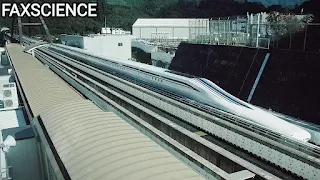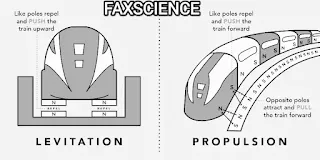WHAT IS A ‘MAGLEV TRAIN’ ?
 |
| Maglev Train |
In this article we are going to see
what is a Maglev Train ?, who were its inventors ?, its working, some of its
test case, its Limitations as well as its Advantages and then warp it up with a
Conclusion.
WHO WERE HER INVENTORS ?
 |
| Robert H. Goddard |
 |
| Eric Laithwaite |
 |
| Dr. Gordon T. Danby and Dr. James R. Powell |
And that's how the idea of floating
trains started, all thanks to these clever scientists who used magnets and
rockets to make trains go fast and float like magic.
HOW DOES THIS SUPER-DUPER FAST TRAIN EVEN WORK ?
In a Maglev train, we use super-duper strong magnets to make it float above the track. These magnets are super cool because they can create really strong magnetic fields when they get super cold, like way colder than freezing!
 |
| Working of a Maglev Train |
There
are three types of these loops on the track:
- One type makes the train hover about 5 inches above the track.
- Another type keeps the train from wobbling side to side.
- The third type helps push the train forward. It's like having magnets in front and behind the train, so it can move.
This special floating design makes
the ride super smooth. Even though the train can go really, really fast, it's
not bumpy like regular trains because there's hardly any friction, just the
air. And guess what? Maglev trains are super safe too! They can't bump into
each other because they all go at the same speed, and they don't have drivers.
Computers control them, and they can change their routes easily. This means in
the future; we could have a super flexible transportation system where trains
go where we need them to go.
The advantages by far that we all
know about them are:
- High Speed: Maglev trains are known for their incredible speed. They can reach speeds of over 600 kilometres per hour (370 miles per hour), making them one of the fastest modes of ground transportation. This high speed can significantly reduce travel time between cities.
- Efficiency: Maglev trains are energy-efficient because they have very little friction. Unlike traditional trains with wheels, there's no contact with the track, so there's minimal energy loss to overcome friction. This efficiency can result in lower operating costs.
- Smooth Ride: Passengers on maglev trains experience a smoother and quieter ride compared to traditional trains. There's no clattering of wheels on tracks, which can make the journey more comfortable.
- Safety: Maglev trains have a strong safety record. Since they are guided by a computerized control system, there's less room for human error. Additionally, because they're powered by the track, there's no risk of derailment due to excessive speed or sharp turns.
- Reduced Environmental Impact: Maglev trains are generally considered more environmentally friendly than some other forms of transportation. They produce fewer greenhouse gas emissions because they use electricity and have high energy efficiency.
LIMITATIONS OF A MAGLEV TRAIN
Here are some of the limitations of
the Maglev Train that I have got by far while researching on them :
- High Construction Cost: Building a maglev system is expensive. The construction of specialized tracks and the development of the necessary infrastructure can be cost-prohibitive for many regions.
- Limited Infrastructure: Maglev systems are not widespread. They require dedicated tracks, which means they can only operate on specific routes. This limits their usefulness for regional or local transportation.
- Limited Cargo Transport: Maglev trains are primarily designed for passengers. While some cargo transport is possible, traditional trains are better suited for moving freight and heavy goods.
- Energy Consumption: While maglev trains are energy-efficient during operation, the process of cooling the superconducting magnets to extremely low temperatures can be energy-intensive.
- Noise During Construction: The construction of maglev tracks can be noisy and disruptive to nearby communities. Excavation, installation of guideways, and other construction activities can be disruptive.
- Weather Sensitivity: Adverse weather conditions, such as snow and ice, can impact the performance of maglev systems. Special measures may be needed to ensure their reliable operation in various weather conditions.
THE TWO POPULAR TEST CASES OF MAGLEV TRAIN YOU NEED TO KNOW :
TEST CASE OF JAPAN :
 |
| H.S.S.T. |
However, a setback occurred when a
train accident resulted in its destruction, prompting the pursuit of a new
design. This design shift culminated in the utilization of the SCMaglev for
testing purposes at the Okazaki exhibition in Japan in 1987. Tests continued at
the Miyazaki facility throughout the 1980s before transitioning to an extended
20-kilometer (12-mile) track in Yamanashi in 1997. Over time, this track has
been further extended to nearly 43 kilometres (27 miles), ultimately serving as
the site where the current world speed record for crewed trains was established
in 2015, reaching a remarkable speed of 603 kilometres per hour (375 mph).
The development journey of HSST began in 1974. The HSST-03, also known as Linimo, gained attention at the Tsukuba World Exposition in 1985, despite its relatively modest top speed of 30 kilometres per hour (19 mph). A subsequent iteration, the HSST-04-1, was unveiled at the Saitama exhibition in Kumagaya in 1988, reaching a top recorded speed of 300 kilometres per hour (190 mph). A significant undertaking in high-speed maglev transportation is the construction of the Chuo Shinkansen line. This initiative, which started in 2014, involves the expansion of the SCMaglev test track in Yamanashi in both directions. The exact completion date for this project remains uncertain, as a recent rejection of a construction permit by local authorities has rendered the previously estimated date of 2027 unattainable.
TEST CASE OF CHINA :
 |
| China's Maglev Train |
A bunch of scientists in China wanted to make trains that are like a mix of regular trains and spaceships. They built a track that's like a tunnel, and they want their trains to zoom through it at super high speeds. It's like the trains are flying on the ground as fast as airplanes in the sky. These special trains don't touch the ground like normal trains. They use magnets to stay up and move forward. That's why they're called "maglev." And guess what? These trains don't have to deal with things like friction, which is like rubbing that slows things down. Also, they run in a special tube with very little air, which helps them go even faster and quieter.
The scientists tried this all out at the beginning of 2023. It was the first time they tested it on a full-size track. And guess what again? Everything worked great! They made sure the train system and everything else worked together just right. To make this super-fast train, they needed really special materials. It's like when you need the right tools to build something cool. The track had to be made from a special kind of metal that doesn't mess with the magnets on the train.
China really likes making fast trains
because it helps people travel quickly and not spend a lot of money. Right now,
they have one super-fast train in use, and it goes from the airport to a city
in just a few minutes. They're building more tracks for these trains to connect
different places, like building a big puzzle to connect cities together. So, in
the future, more people can ride these super-fast maglev trains and get where
they want to go really quickly!
FUN FACT
Here is some interesting fact table, I have made for you all :
 |
| Statistical Data Table |
CONCLUSION
In conclusion, we can conclude that a
Maglev train is like a super cool train that floats above the tracks using
powerful magnets. These magnets make the train levitate and go really fast
without touching the ground. It's kind of like magic! Some really smart people,
like Robert H. Goddard and Dr. Gordon T. Danby, came up with this amazing idea.
They used super cold magnets and special tracks to make the train float and
move smoothly. It's like a smooth ride in the air!
Maglev trains have some super cool
advantages. They can go incredibly fast, which means we can travel to faraway
places quickly. They are also energy-efficient and environmentally friendly.
Plus, they are safe and don't get stuck in traffic. But there are some
challenges too. Building the tracks and infrastructure can be expensive, and
they can only run on specific routes. Also, making them requires special
materials and can be noisy during construction.
China and Japan are two places where
Maglev trains are being tested and used. China is especially excited about them
and is building more tracks to connect cities faster. So, in the future, we
might see more of these floating trains, and they could change the way we
travel. Imagine going on a super-fast train ride that feels like magic!
